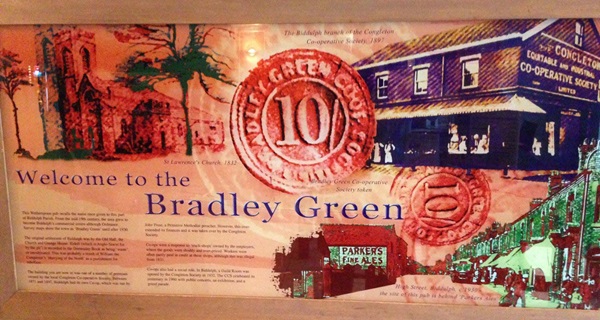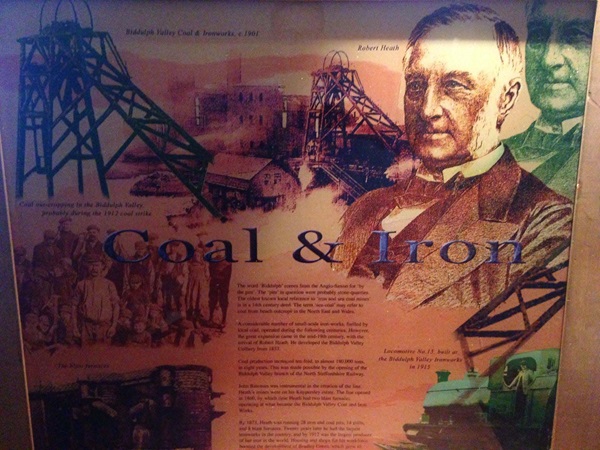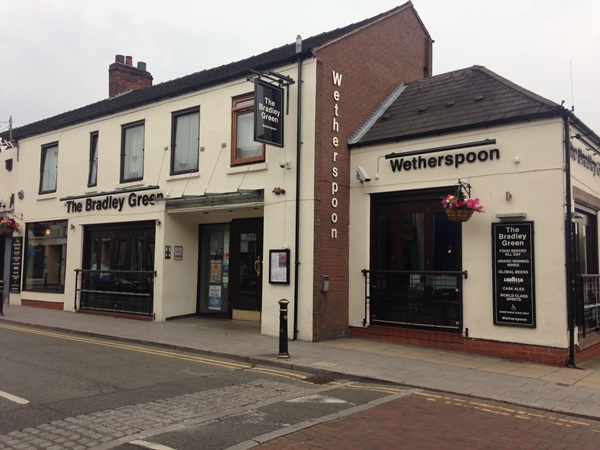In the days of coal and iron, Biddulph was actually called Bradley Green, the original site of Biddulph being the area in which the parish church, Grange House, and the ruins of Biddulph Old Hall stand. It was not until 1930 that the town was marked on Ordnance Survey maps as ‘Biddulph
A print and text about The Bradley Green.

The text reads: This Wetherspoon pub recalls the name once given to this part of Biddulph Parish. From the mid 19th century, the area grew to become Biddulph’s commercial centre although Ordnance Survey maps show the town as Bradley Green until after 1930.
The original settlement of Biddulph was by the Old Hall, the church and Grange House. Bidolf (which is Anglo-Saxon for ‘by the pit’) is recorded in the Domesday Book as being ‘waste’, or uncultivated. This was probably a result of William the Conqueror’s Harrying of the North as a punishment for the rebellion.
The building you are now in was one of a number of premises owned by the local Congleton Co-operative Society. Between 1871 and 1897, Biddulph had its own Co-op, which was run by John Frost, a Primitive Methodist preacher. However, this over-extended its finances and it was taken over by the Congleton Society.
Co-ops were a response to truck shops owned by the employers, where the goods were shoddy and overpriced. Workers were often partly paid in credit at these shops, although this was illegal from 1831.
Co-ops also had a social role. In Biddulph a Guild Room was opened by the Congleton Society in 1932. The CCS celebrated its centenary in 1960 with public concerts, an exhibition, and a grand parade.
A print and text about coal and iron works.

The text reads: The word Biddulph comes from the Anglo- Saxon for ‘by the pits’. The pits in question were probably stone-quarries. The oldest known local reference to ‘iron and sea coal mines’ is in a 14th century deed. The term ‘seal coal’ may refer to coal from beach outcrops in the north east and Wales.
A considerable number pf small scale iron works, fuelled by local coal, operated during the following centuries. However, the great expansion came in the mid 19th century, with the arrival of Robert Heath. He developed the Biddulph Valley Colliery from 1857.
Coal production increased ten-fold, to almost 180,000 tons in eight years. This was made possible by the opening of the Biddulph Valley branch of the North Staffordshire Railway.
John Bateman was instrumental in the creation of the line. Heath’s miners were on his Knypersley estate. The line opened in 1860, by which time Heath had two blast furnaces operating at what became the Biddulph Valley Coal and Iron Works.
By 1873, Heath was running 28 iron and coal pits, 14 mills, and 8 blast furnaces. Twenty years later he had the largest ironworks in the country, and by 1912 was the largest producer of bar irons in the world. Housing and shops for his workforce boosted the development of Bradley Green, which grew to become the centre of Biddulph.
External photograph of the building – main entrance.

If you have information on the history of this pub, then we’d like you to share it with us. Please e-mail all information to: pubhistories@jdwetherspoon.co.uk